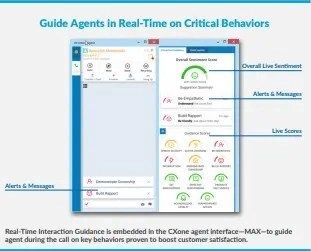What is digital customer experience software?
In the contact center, digital customer experience software is a collection of applications that make operations more efficient and CX consistently better.It typically includes foundational contact center tools such as automatic contact distributors (ACDs), interactive voice response (IVR) systems, and workforce management (WFM) solutions. But modern customer experience software takes these tools to another level by infusing them with artificial intelligence so that forecasts and schedules are more accurate, routing is smarter, and voice self-service is more effective.Beyond these core applications, digital customer experience software includes a host of solutions that help manage and improve the quality of CX, including integrated voice and digital channels, virtual agents, automation systems, end-to-end interaction analytics, real-time reporting dashboards, and more.Collectively, these solutions enable contact centers to provide proactive, personalized, omnichannel customer service experiences. And, they help optimize operations and keep agents informed, engaged, and satisfied, while ensuring they have the right skills to excel at their job.No flip phones here!The right digital customer experience software can empower contact centers to meet top customer expectations
When it comes to CX, there are some common, fundamental things customers want from businesses. PwC research found that "nearly 80% of American consumers point to speed, convenience, knowledgeable help and friendly service as the most important elements of a positive customer experience."[1]Let's take a closer look at all four elements individually.1. Speed - customers want instant gratification
Customers have been conditioned to expect speed by services such as streaming videos, two-hour grocery delivery, car rides on demand, and search engines that take less than a second to return thousands of results. We're in the age of instant gratification and contact centers need to keep up.Here are some areas where businesses can focus to add more speed to customer service experiences.Reduce wait times and response times
Contact center leaders know they need to respond to customers quickly (keep “wait” times low), nonetheless this bears further discussion because customers really don't like to wait. According to HubSpot, 90% of consumers believe immediate response times from businesses are "important" or "very important" for customer support issues, with "immediate" meaning within 10 minutes.[2]Meeting service levels, of course, begins with optimized forecasts and agent schedules. If contact centers are still using spreadsheets for forecasting, it's time to trade in the flip phone for a smartphone. Modern workforce management software makes forecasting and scheduling easier and more accurate.Additionally, it enables speedy intraday adjustments, providing the flexibility businesses need to effectively react to unexpected volume fluctuations. These combined capabilities help ensure the right number of agents are staffed at the right times, ultimately leading to the lower wait times customers expect.Contact centers also need to set goals for turnaround times on emails and other asynchronous interactions that are in line with customer expectations. People expect some time lag when they use these channels, but not a very large delay like a week, or maybe not even a day. One survey found that nearly one-third of consumers expect businesses to respond to their support emails in an hour or less.[3]Improve first contact resolution (FCR) rates
Requiring customers to call back about ongoing issues is the antithesis of speed. A major component of fast service is resolving issues the first time customers contact support. This requires:- Optimized routing
- Trained and empowered agents
- Intuitive and well-maintained knowledge base
- Well-designed self-service solutions with seamless paths to agent assistance
2. Customers want their support experiences to be convenient
Not only do customers expect fast service, but they also want to interact with businesses on their own terms. Convenience is all about offering choices and making it easy for customers to get resolutions.Here are some ways digital customer experience software can help inject convenience into customer service experiences.Engage earlier for more proactive and convenient resolutions
The contact center is not the starting point for most resolution journeys. A majority of people first seek help online, through a search engine. Businesses can make it easier for these customers to receive the answers they’re looking for by extending knowledge articles to search results. This makes support more convenient and keeps customers from going to competitors for answers.Offer multiple, integrated digital channels
Convenience means letting customers choose the channel that is most suited to their issue and their schedule. A customer may want to use online chat for more urgent issues and messaging for simple questions that aren't time sensitive. Or if they are doing something that prevents real-time communication, they may just want to send a quick email and check the response later.But offering channel choice isn't enough. Customers must be able to seamlessly move across channels for omnichannel experiences. Otherwise, being required to start from scratch when switching channels can leech the convenience right out of all those digital channels.The right digital customer experience software can enable omnichannel experiences with capabilities such as omnichannel routing, forecasting and scheduling, and unified agent desktops that enable agents to easily help customers from multiple channels.Provide effective self-service that will satisfy your DIY-ers
"Effective" is a key word here. Gartner found that 70% of customers use self-service channels during their resolution journey. Unfortunately, only 9% are wholly contained in self-service.[4]When customers can successfully handle their own matters, it's a win for both customers and businesses. Customers who prefer to self-serve get the convenience they value, while companies resolve customer issues at a much lower cost per contact.
3. Customers expect knowledgeable help
Sounds reasonable, right? But this can be hard to deliver when a consistently large percentage of your agents are new. High turnover rates are the enemy of this customer expectation.Good onboarding and ongoing training are essential for making and keeping agents knowledgeable, but the right digital customer experience software also includes features, such as the following, to help agents provide smart answers and resolutions.Implement a user-friendly knowledge base
Agents can't be expected to know everything, and even the most experienced agents have occasional memory lapses. Troubleshooting customer issues shouldn't be like the closed-book tests we all took in school. Sometimes the best kind of knowledge is simply knowing where to look for answers. A well-maintained, easy to use knowledge base can be the "open textbook" agents need to provide customers with satisfyingly accurate help.The expectation of "knowledgeable help" also applies to self-service tools. A good knowledge base should also be accessed by solutions such as website search, virtual agents, and conversational IVRs in order to provide customers with consistent answers in every channel they use.Give agents their own, smart virtual attendant

Use collaborative quality management systems to continuously improve agent knowledge and performance
Quality monitoring processes help measure agent accuracy and identify knowledge gaps. Contact centers still using manual QM processes should automate to realize the best results. Modern quality management applications simplify scorecard creation, analyze 100% of interactions making pulling samples easy, and provide a two-way collaboration platform so agents can provide input into or dispute their evaluations.4. Customers want friendly service
This expectation highlights the importance of soft skills. Not only do agents need to be knowledgeable, they also need to be personable. Contact centers need to include soft skills training in their curriculums so agents are proficient at showing empathy, taking charge, active listening, and more.Digital customer experience software can help agents be more friendly by guiding them during interactions and improving the employee experience.Give guidance, in real-time
AI-powered real-time interaction guidance software listens to and analyzes voice interactions while they're happening. The tool analyzes customer and agent behavior and language to identify and coach agents on skills that can make a more satisfying customer service experience.For example, if a customer is speaking fast and loudly and using words like "mad," the real-time interaction guidance tool would determine their sentiment is negative and maybe prompt the agent to show more empathy. Or if an agent repeatedly interrupts a customer, the tool will coach him to use better active listening skills.Improve the agent experience
It is often said that if you take good care of your agents, they will take good care of your customers. This isn’t just a baseless figure of speech. Research, including a recent study by Glassdoor, finds a strong statistical correlation between employee well-being and customer satisfaction.[5]Modern digital customer experience software can improve the agent experience by being much more usable than retro technology and empowering agents to be more successful at helping customers. As an example, would you rather send a text message on a flip phone or a smartphone? The experiences are worlds apart.When contact centers implement a unified agent desktop, they're essentially giving agents the contact center version of a smartphone. Everything an agent needs to do her job can be integrated into a single interface, including all support channels, CRM systems, help desk ticket applications, knowledge bases, and more.In addition to improving the agent experience through more usable and effective technical tools, digital customer experience software can also make the nature of an agent's work more fulfilling. For example, automation and self-service both reduce the number of mundane tasks agents must handle, allowing them to spend more time on higher value transactions.Modern solutions also help improve work-life balance through more flexible scheduling and native work from home capabilities.The case is extraordinarily strong for contact center modernization. Businesses need the best technology to meet these top customer expectations. Ready to retire your retro contact center systems? See what NICE CXone, the industry's leading digital customer experience software, can do for your organization's CX.[1] PwC: Experience is everything: Here’s how to get it right (2018)[2] Hubspot: Live Chat Exposes a Fatal Flaw in Your Go-to-Market
[3] Toister Solutions: How quickly should you respond to email? (2020)
[4] Gartner: Rethink Your Customer Service Strategy to Drive Self-Service (2019)
[5] Harvard Business Review: The Key to Happy Customers? Happy Employees (2019)









